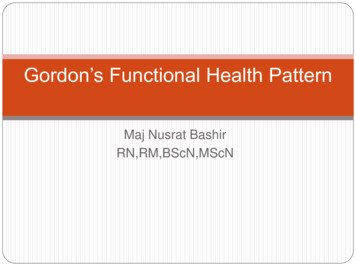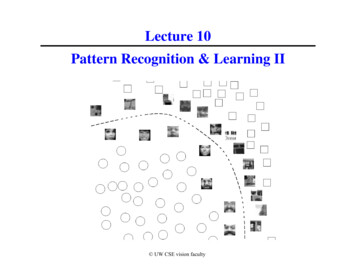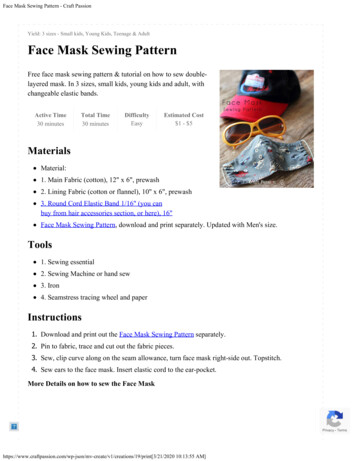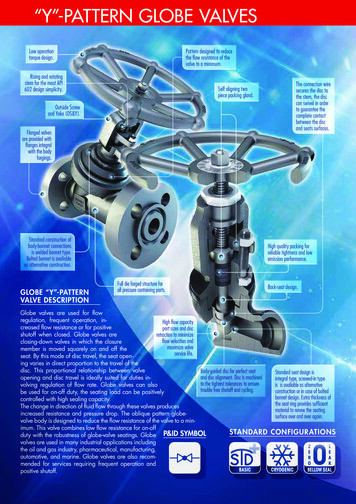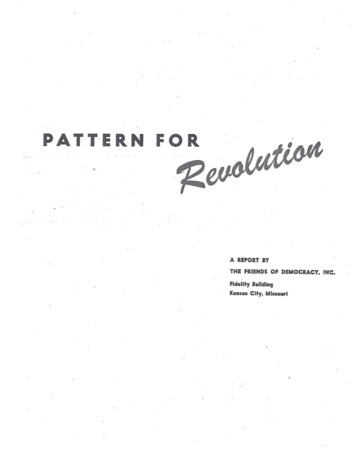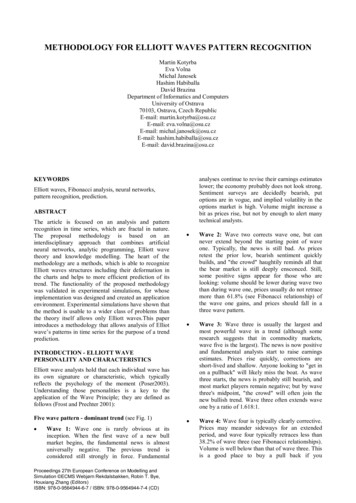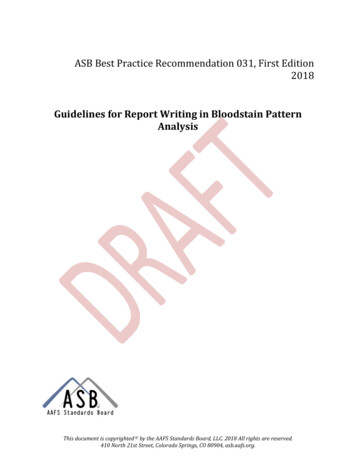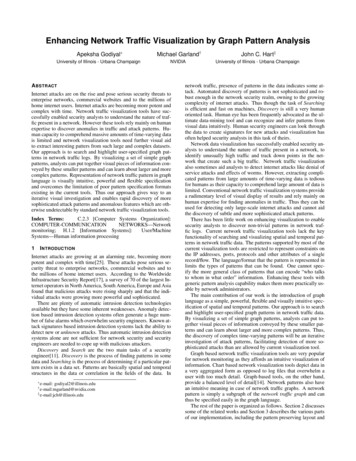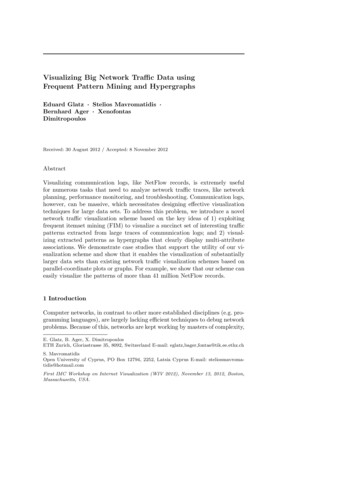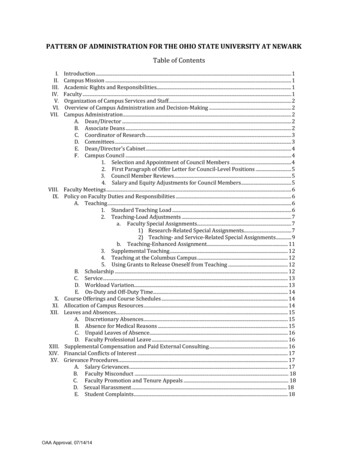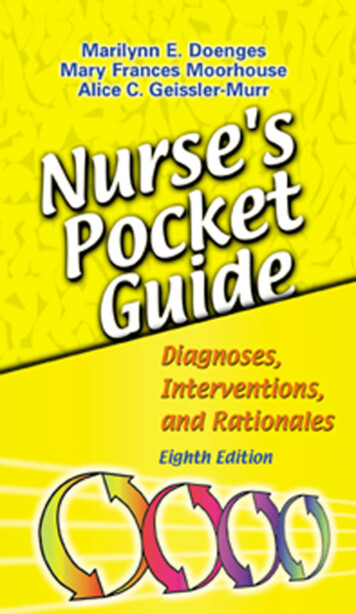
Transcription
Copyright 2002 F.A. Davis CompanyImage/Text rights unavailable
Copyright 2002 F.A. Davis CompanyACTIVITY-EXERCISE PATTERNActivity intolerance, risk forActivity intolerance (specify level)Aspiration, risk forAdaptive capacity, decreased, intracranialInfant behavior, disorganizedInfant behavior, risk for disorganizedInfant behavior, readiness for enhanced organizedFatiguePhysical mobility, impairedBed mobility, impairedWalking, impairedWheelchair mobility, impairedWheelchair transfer ability, impairedDevelopment, risk for delayedDysreflexiaAutonomic dysreflexia, risk forDisuse syndrome, risk forSelf-care deficit (specify: bathing/hygiene, dressing/grooming, feeding, toileting)Diversional activity deficientHome maintenance, impairedDysfunctional Ventilatory Weaning ResponseVentilation, impaired spontaneousAirway clearance, ineffectiveBreathing pattern, ineffectiveGas exchange, impairedCardiac output, decreasedTissue perfusion, alteration (specify)Peripheral neurovascular dysfunction, risk forPerioperative positioning injury, risk forGrowth and development, delayedGrowth, risk for disproportionateWanderingSLEEP-REST PATTERNSleep-pattern disturbanceSleep deprivationCOGNITIVE-PERCEPTUAL PATTERNPain, acuteChronic painSensory perception, disturbed (specify)Unilateral neglectKnowledge deficit (specify)Unilateral neglectKnowledge deficit (specify)Memory, impairedThought processes, disturbedAcute confusionChronic confusionDecisional conflict (specify)SELF-PERCEPTION--SELF-CONCEPT PATTERNFearAnxietyAnxiety , deathHopelessnessPowerlessnessPowerlessness, risk forLoneliness, risk forSelf-esteem disturbedChronic low self-esteemSituational low self-esteemRisk for self-esteem situational lowBody image disturbancePersonal identity disturbance
Copyright 2002 F.A. Davis CompanyROLE-RELATIONSHIP PATTERNAnticipatory grievingDysfunctional grievingChronic sorrowRole performance, ineffectiveSocial isolationImpaired social interactionRelocation stress syndromeRisk for relocation stress syndromeFamily processes, interruptedDysfunctional family processes: alcoholismRisk for impaired parentingImpaired parentingRisk for impaired parent/infant/child attachmentParental role conflictCaregiver role strainRisk for caregiver role strainImpaired verbal communicationRisk for violence, directed at selfRisk for violence, directed at othersSEXUALITY-REPRODUCTIVESexual dysfunctionIneffective sexuality patternsRape Trauma syndromeRape-Trauma syndrome: compound reactionRape-Trauma syndrome: silent reactionCOPING-STRESS TOLERANCE PATTERNIneffective copingDefensive copingCommunity coping, ineffectiveCommunity coping, readiness for enhancedIneffective denialImpaired adjustmentPost-Trauma syndromeRisk for post-trauma syndromeFamily coping: readiness for enhancedIneffective family coping: compromisedIneffective family coping: disablingRisk for violence, directed at selfRisk for violence, directed at othersRisk for suicideSelf-mutilationRisk for self-mutilationVALUE-BELIEF PATTERNSpiritual distressRisk for spiritual distressSpiritual Well-Being, readiness for enhanced
Copyright 2002 F.A. Davis CompanyNurse’s Pocket GuideDiagnoses, Interventions,and RationalesEIGHTH EDITIONMarilynn E. Doenges, RN, BSN, MA, CS, APNClinical SpecialistAdult Psychiatric/Mental Health Nursing, RetiredAdjunct FacultyBeth-El College of Nursing and Health Sciences CU-SpringsColorado Springs, ColoradoMary Frances Moorhouse, RN, BSN, CRRN, CLNCNurse ConsultantTNT-RN EnterprisesColorado Springs, ColoradoAlice Geissler-Murr, RN, BSN, CLNCContract PractitionerLegal Nurse ConsultantColorado Springs, ColoradoF.A. Davis Company Philadelphia
Copyright 2002 F.A. Davis CompanyF. A. Davis Company1915 Arch StreetPhiladelphia, PA 19103www.fadavis.comCopyright 2002 by F. A. Davis CompanyCopyright 1985, 1988, 1991, 1993, 1996, 1998, 2000 by F. A. Davis Company. Allrights reserved. This book is protected by copyright. No part of it may be reproduced, stored in a retrieval system, or transmitted in any form or by any means,electronic, mechanical, photocopying, recording, or otherwise, without writtenpermission from the publisher.Printed in CanadaLast digit indicates print number: 10 9 8 7 6 5 4 3 2 1Publisher: Robert G. MartoneCover Design: Louis J. ForgioneAs new scientific information becomes available through basic and clinicalresearch, recommended treatments and drug therapies undergo changes. Theauthor(s) and publisher have done everything possible to make this book accurate,up to date, and in accord with accepted standards at the time of publication. Theauthors, editors, and publisher are not responsible for errors or omissions or forconsequences from application of the book, and make no warranty, expressed orimplied, in regard to the contents of the book. Any practice described in this bookshould be applied by the reader in accordance with professional standards of careused in regard to the unique circumstances that may apply in each situation. Thereader is advised always to check product information (package inserts) forchanges and new information regarding dose and contraindications beforeadministering any drug. Caution is especially urged when using new or infrequently ordered drugs.Library of Congress Cataloging-in-Publication DataDoenges, Marilynn E., 1922–Nurse’s pocket guide: diagnosis, interventions, and rationales / Marilynn E.Doenges, Mary Frances Moorhouse, Alice Geissler-Murr.—8th ed.p. ; cm.Includes bibliographical references and index.ISBN 0-8036-0948-51. Nursing diagnosis--Handbooks, manuals, etc. I. Moorhouse, MaryFrances, 1947- II. Geissler-Murr, Alice, 1946- III. Title.[DNLM: 1. Nursing Diagnosis--Handbooks. 2. Nursing Care--classification-Handbooks. 3. Patient Care Planning--Handbooks. WY 49 D641n 2002]RT48.6 .D64 2002610.73--dc212001058273Authorization to photocopy items for internal or personal use, or the internal orpersonal use of specific clients, is granted by F. A. Davis Company for users registered with the Copyright Clearance Center (CCC) Transactional ReportingService, provided that the fee of .10 per copy is paid directly to CCC, 222Rosewood Drive, Danvers, MA 01923. For those organizations that have beengranted a photocopy license by CCC, a separate system of payment has beenarranged. The fee code for users of the Transactional Reporting Service is: 80360948/02 0 .10.
Copyright 2002 F.A. Davis CompanyThis book is dedicated to:Our families, who helped with the mundane activities ofdaily living that allowed us to write this book and who provideus with love and encouragement in all our endeavors.Our friends, who support us in our writing, put up with ourmemory lapses, and love us still.Bob Martone, Publisher, Nursing, who asks questions thatstimulate thought and discussion, and who maintains goodhumor throughout.The F. A. Davis production staff, who coordinated and expedited the project through the printing process, meeting unrealdeadlines, and sending pages to us with bated breath.Robert H. Craven, Jr., and the F. A. Davis family.And last and most important:The nurses we are writing for, to those who have found theprevious edition of the Pocket Guide helpful, and to other nurses who are looking for help to provide quality nursing care in aperiod of transition and change, we say, “Nursing Diagnosis isthe way.”AcknowledgmentsA special acknowledgment to Marilynn’s friend, the lateDiane Camillone, who provoked an awareness of the role of thepatient and continues to influence our thought about theimportance of quality nursing care, and our late colleague, MaryJeffries, who introduced us to nursing diagnosis.To our colleagues in NANDA who continue to formulate andrefine nursing diagnosis to provide nursing with the tools toenhance and promote the growth of the profession.Marilynn E. DoengesMary Frances MoorhouseAlice Geissler-Murr
Copyright 2002 F.A. Davis CompanyThis page intentionally left blank
Copyright 2002 F.A. Davis CompanyContentsDisorder/Health Problems with Associated Nursing Diagnosesappear on pages 576–680.How to Use the Nurse’s Pocket Guide .ixCHAPTER 1The Nursing Process .1CHAPTER 2Application of the Nursing Process .4CHAPTER 3Putting Theory into Practice: Sample AssessmentTools, Plan of Care, and Documentation .11SECTION 1Assessment Tools for Choosing Nursing Diagnoses .14Adult Medical/Surgical Assessment Tool15Excerpt from Psychiatric Assessment Tool 25Excerpt from Prenatal Assessment Tool28Excerpt from Intrapartal Assessment Tool 30SECTION 2Diagnostic Divisions: Nursing Diagnoses OrganizedAccording to a Nursing Focus.32SECTION 3Patient Situation and Prototype Plan of Care .37SECTION 4Documentation Techniques: SOAP and FocusCharting . 52CHAPTER 4Nursing Diagnoses in Alphabetical Order . 57For each nursing diagnosis, the following information is provided:Taxonomy II, Domain, Class, CodeDiagnostic DivisionDefinitionRelated/Risk Factors, Defining Characteristics:Subjective/Objectivevii
Copyright 2002 F.A. Davis CompanyDesired Outcomes/Evaluation CriteriaActions/InterventionsNursing PrioritiesDocumentation FocusSample Nursing Outcomes & Interventions Classifications(NOC/NIC)CHAPTER 5Disorders/Health Problems with Associated NursingDiagnoses .576APPENDIX 1Taxonomy II . 681APPENDIX 2Definitions of Taxonomy II Axes .685APPENDIX 3Proposed ICD-10 Version of NANDA’s Taxonomy 1Revised . 688Bibliography .693Index . 703viiiNURSE’S POCKET GUIDE
Copyright 2002 F.A. Davis CompanyHow to Use the Nurse’sPocket GuideThe American Nurses Association (ANA) Social PolicyStatement of 1980 was the first to define nursing as the diagnosis and treatment of human responses to actual and potentialhealth problems. This definition, when combined with the ANAStandards of Practice, has provided impetus and support for theuse of nursing diagnosis. Defining nursing and its effect onpatient care supports the growing awareness that nursing care isa key factor in patient survival and in the maintenance, rehabilitative, and preventive aspects of healthcare. Changes and newdevelopments in healthcare delivery in the last decade havegiven rise to the need for a common framework of communication to ensure continuity of care for the patient moving betweenmultiple healthcare settings and providers. Evaluation and documentation of care are important parts of this process.This book is designed to aid the practitioner and studentnurse in identifying interventions commonly associated withspecific nursing diagnoses as proposed by the North AmericanNursing Diagnosis Association (NANDA). These interventionsare the activities needed to implement and document care provided to the individual patient and can be used in varied settings from acute to community/home care.Chapters 1 and 2 present brief discussions of the nursingprocess, data collection, and care plan construction. Chapter 3contains the Diagnostic Divisions, Assessment Tool, a sampleplan of care, and corresponding documentation/charting examples. For more in-depth information and inclusive plans of carerelated to specific medical/psychiatric conditions (with rationale and the application of the diagnoses), the nurse is referredto the larger works, all published by the F. A. Davis Company:Nursing Care Plans: Guidelines for Planning and DocumentingPatient Care, ed. 6 (Doenges, Moorhouse, Geissler, 2002);Psychiatric Care Plans: Guidelines for Planning and DocumentingClient Care, ed. 3 (Doenges, Townsend, Moorhouse, 1998);Maternal/Newborn Plans of Care: Guidelines for Planning andDocumenting Client Care, ed. 3 (Doenges, Moorhouse, 1999).Nursing diagnoses are listed alphabetically in Chapter 4 forease of reference and include the diagnoses accepted for use byNANDA through 2001. Each approved diagnosis includes itsdefinition and information divided into the NANDA categoriesof Related or Risk Factors and Defining Characteristics.ix
Copyright 2002 F.A. Davis CompanyRelated/Risk Factors information reflects causative or contributing factors that can be useful for determining whether thediagnosis is applicable to a particular patient. DefiningCharacteristics (signs and symptoms or cues) are listed as subjective and/or objective and are used to confirm actual diagnoses, aid in formulating outcomes, and provide additional datafor choosing appropriate interventions. The authors have notdeleted or altered NANDA’s listings; however, on occasion, theyhave added to their definitions and suggested additional criteriato provide clarification and direction. These additions aredenoted with brackets [ ].With the development and acceptance of Taxonomy II following the biennial conference in 2000, significant changes weremade to better reflect the content of the diagnoses within thetaxonomy. It is designed to reduce miscalculations, errors, andredundancies. The framework has been changed from theHuman Response Patterns and is organized in Domains andClasses, with 13 domains, 105 classes and 155 diagnoses.Although clinicians will use the actual diagnoses, understandingthe taxonomic structure will help the nurse to find the desiredinformation quickly. Taxonomy II is designed to be multiaxialwith 7 axes (see Appendix 2). An axis is defined as a dimensi
Impaired verbal communication Risk for violence, directed at self Risk for violence, directed at others SEXUALITY-REPRODUCTIVE Sexual dysfunction Ineffective sexuality patterns Rape Trauma syndrome Rape-Trauma syndrome: compound reaction Rape-Trauma syndrome: silent reaction COPING-STRESS TOLERANCE PATTERN Ineffective coping Defensive coping Community coping,

